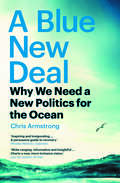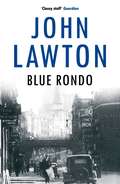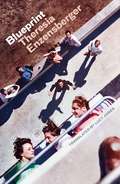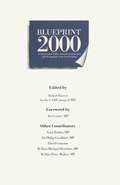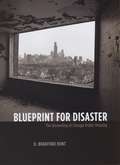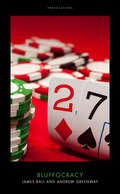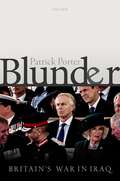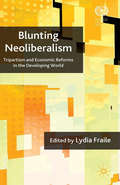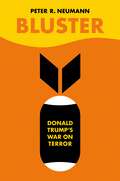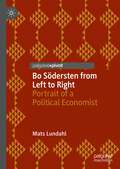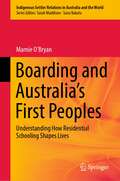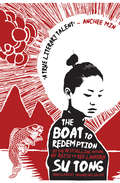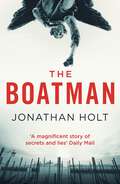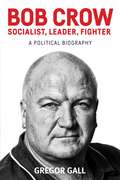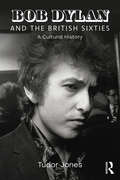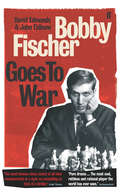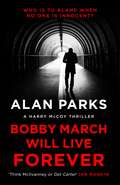- Table View
- List View
A Blue New Deal: Why We Need a New Politics for the Ocean
by Chris ArmstrongAn urgent account of the state of our oceans today—and what we must do to protect themThe ocean sustains life on our planet, from absorbing carbon to regulating temperatures, and, as we exhaust the resources to be found on land, it is becoming central to the global market. But today we are facing two urgent challenges at sea: massive environmental destruction, and spiraling inequality in the ocean economy.Chris Armstrong reveals how existing governing institutions are failing to respond to the most pressing problems of our time, arguing that we must do better. Armstrong examines these crises—from the fate of people whose lands will be submerged by sea level rise, to the exploitation of people working in fishing, to the rights of marine animals—and makes the case for a powerful World Ocean Authority capable of tackling them. A Blue New Deal presents a radical manifesto for putting equality, democracy, and sustainability at the heart of ocean politics.
Blue Rondo (Inspector Troy series #5)
by John LawtonWritten by 'a sublimely elegant historical novelist as addictive as crack' (Daily Telegraph), the Inspector Troy series is perfect for fans of Le Carré, Philip Kerr and Alan Furst.1959.An old flame has returned to Troy's life: Kitty Stilton, now wife of an American presidential hopeful, has come back to London, and with her, an unwelcome guest.Private eye Joey Rork has been hired to make sure Kitty's amorous liaisons don't ruin her husband's political career. But before Rork can dig any dirt, he meets a gruesome end...But he isn't the only one, and with the body-count mounting is it possible that the blood trail leads back to Troy's police force and into his own forgotten past?
Bluefield Housing as Alternative Infill for the Suburbs
by Damian MadiganSuburbanised cities share a common dilemma: how to transition to more densely populated and socially connected urban systems while retaining low-rise character, avoiding gentrification, and opening neighbourhoods to more diverse housing choices. Bluefield Housing offers a new land definition and co-located infill model addressing these concerns, through describing and deploying the types of ad-hoc modifications that have been undertaken in the suburbs for decades. Extending green-, brown-, and greyfield definitions, it provides a necessary middle ground between the ‘do nothing’ attitude of suburban preservation and the ‘do everything’ approach of knock-down-rebuild regeneration.An adjunct to ‘missing middle’ and subdivision densification models, with a focus on co-locating homes on small lots, Bluefield Housing presents a unified design approach to suburban infill: retrofitting original houses, retaining and enhancing landscape and urban tree canopies, and delivering additional homes as low-rise additions and backyard homes suited to the increasingly complex make-up of our households.Extensively illustrated by the author with engaging architectural design studies, Damian Madigan describes how existing quirks of suburban housing can prompt new forms of infill, explains why a new suburban densification model is not only necessary but can be made desirable for varied stakeholders, and charts a path towards the types of statutory and market triggers required to make bluefield housing achievable. Using Australian housing as an example but addressing universal concerns around neighbourhood character, demographic needs, housing diversity, dwelling flexibility, and landscape amenity, Bluefield Housing offers innovative suburban infill ideas for policy makers, planners, architects, researchers and students of housing and design studies, and for those with a stake in the future of the suburbs.The Open Access version of this book, available at www.taylorfrancis.com, has been made available under a Creative Commons Attribution-Non Commercial-No Derivatives (CC-BY-NC-ND) 4.0 license.
Bluefield Housing as Alternative Infill for the Suburbs
by Damian MadiganSuburbanised cities share a common dilemma: how to transition to more densely populated and socially connected urban systems while retaining low-rise character, avoiding gentrification, and opening neighbourhoods to more diverse housing choices. Bluefield Housing offers a new land definition and co-located infill model addressing these concerns, through describing and deploying the types of ad-hoc modifications that have been undertaken in the suburbs for decades. Extending green-, brown-, and greyfield definitions, it provides a necessary middle ground between the ‘do nothing’ attitude of suburban preservation and the ‘do everything’ approach of knock-down-rebuild regeneration.An adjunct to ‘missing middle’ and subdivision densification models, with a focus on co-locating homes on small lots, Bluefield Housing presents a unified design approach to suburban infill: retrofitting original houses, retaining and enhancing landscape and urban tree canopies, and delivering additional homes as low-rise additions and backyard homes suited to the increasingly complex make-up of our households.Extensively illustrated by the author with engaging architectural design studies, Damian Madigan describes how existing quirks of suburban housing can prompt new forms of infill, explains why a new suburban densification model is not only necessary but can be made desirable for varied stakeholders, and charts a path towards the types of statutory and market triggers required to make bluefield housing achievable. Using Australian housing as an example but addressing universal concerns around neighbourhood character, demographic needs, housing diversity, dwelling flexibility, and landscape amenity, Bluefield Housing offers innovative suburban infill ideas for policy makers, planners, architects, researchers and students of housing and design studies, and for those with a stake in the future of the suburbs.The Open Access version of this book, available at www.taylorfrancis.com, has been made available under a Creative Commons Attribution-Non Commercial-No Derivatives (CC-BY-NC-ND) 4.0 license.
Blueprint: A powerful coming-of-age novel about a female Bauhaus student in the 1920s
by Theresia Enzensberger'This powerful novel tells a story of a time past that feels eerily reflective of the present' Sunday Times'Bring[s] to life the Bauhaus movement' ElleLUISE SCHILLING WANTS TO TEAR DOWN THE PAST AND BUILD A NEW FUTURE.At the beginning of the turbulent 1920s, she leaves her father's conservative household in Berlin for Weimar's Bauhaus university, with dreams of studying architecture. But when she arrives and encounters a fractured social world of mystics and formalists, communists and fascists, the dichotomy between the rigid past and a hopeful future turns out to be a lot more muddled than she thought. She gets involved with a cult-like spiritual group, looking for community and falling in love with elusive art student Jakob. Luise has ambitions of achieving a lot in life - but little of it has to do with paying homage to great men. Surrounded by luminaries, like Gropius and Kandinsky, she throws herself into the dreams and ideas of her epoch.While her art school friends retreat into a world of self-improvement and jargon, her home city of Berlin is embroiled in street fights. Amid the social upheaval, she has to decide where she stands. From technology to art, romanticism to the avant-garde, populism to the youth movement, Luise encounters themes, utopias and ideas that still shape us to the present day. Blueprint is a young woman's dispatch from a past culture war that rings all too familiar. Perfect for fans of The Secret History by Donna Tartt and The Last Nude by Ellis Avery.
Blueprint 2000
by Jim Lester R. HarveyAn attempt by Conservative MPs to put forward and explain their views regarding the so-called technological revolution. The contributors suggest that government must face the challenge of managing the social consequences of this change or risk social upheaval and misery.
Blueprint for Disaster: The Unraveling of Chicago Public Housing (Historical Studies of Urban America)
by D. Bradford HuntNow considered a dysfunctional mess, Chicago’s public housing projects once had long waiting lists of would-be residents hoping to leave the slums behind. So what went wrong? To answer this complicated question, D. Bradford Hunt traces public housing’s history in Chicago from its New Deal roots through current mayor Richard M. Daley’s Plan for Transformation. In the process, he chronicles the Chicago Housing Authority’s own transformation from the city’s most progressive government agency to its largest slumlord. Challenging explanations that attribute the projects’ decline primarily to racial discrimination and real estate interests, Hunt argues that well-intentioned but misguided policy decisions—ranging from design choices to maintenance contracts—also paved the road to failure. Moreover, administrators who fully understood the potential drawbacks did not try to halt such deeply flawed projects as Cabrini-Green and the Robert Taylor Homes. These massive high-rise complexes housed unprecedented numbers of children but relatively few adults, engendering disorder that pushed out the working class and, consequently, the rents needed to maintain the buildings. The resulting combination of fiscal crisis, managerial incompetence, and social unrest plunged the CHA into a quagmire from which it is still struggling to emerge. Blueprint for Disaster, then,is an urgent reminder of the havoc poorly conceived policy can wreak on our most vulnerable citizens.
Blueprint for Disaster: The Unraveling of Chicago Public Housing (Historical Studies of Urban America)
by D. Bradford HuntNow considered a dysfunctional mess, Chicago’s public housing projects once had long waiting lists of would-be residents hoping to leave the slums behind. So what went wrong? To answer this complicated question, D. Bradford Hunt traces public housing’s history in Chicago from its New Deal roots through current mayor Richard M. Daley’s Plan for Transformation. In the process, he chronicles the Chicago Housing Authority’s own transformation from the city’s most progressive government agency to its largest slumlord. Challenging explanations that attribute the projects’ decline primarily to racial discrimination and real estate interests, Hunt argues that well-intentioned but misguided policy decisions—ranging from design choices to maintenance contracts—also paved the road to failure. Moreover, administrators who fully understood the potential drawbacks did not try to halt such deeply flawed projects as Cabrini-Green and the Robert Taylor Homes. These massive high-rise complexes housed unprecedented numbers of children but relatively few adults, engendering disorder that pushed out the working class and, consequently, the rents needed to maintain the buildings. The resulting combination of fiscal crisis, managerial incompetence, and social unrest plunged the CHA into a quagmire from which it is still struggling to emerge. Blueprint for Disaster, then,is an urgent reminder of the havoc poorly conceived policy can wreak on our most vulnerable citizens.
Blueprint for Disaster: The Unraveling of Chicago Public Housing (Historical Studies of Urban America)
by D. Bradford HuntNow considered a dysfunctional mess, Chicago’s public housing projects once had long waiting lists of would-be residents hoping to leave the slums behind. So what went wrong? To answer this complicated question, D. Bradford Hunt traces public housing’s history in Chicago from its New Deal roots through current mayor Richard M. Daley’s Plan for Transformation. In the process, he chronicles the Chicago Housing Authority’s own transformation from the city’s most progressive government agency to its largest slumlord. Challenging explanations that attribute the projects’ decline primarily to racial discrimination and real estate interests, Hunt argues that well-intentioned but misguided policy decisions—ranging from design choices to maintenance contracts—also paved the road to failure. Moreover, administrators who fully understood the potential drawbacks did not try to halt such deeply flawed projects as Cabrini-Green and the Robert Taylor Homes. These massive high-rise complexes housed unprecedented numbers of children but relatively few adults, engendering disorder that pushed out the working class and, consequently, the rents needed to maintain the buildings. The resulting combination of fiscal crisis, managerial incompetence, and social unrest plunged the CHA into a quagmire from which it is still struggling to emerge. Blueprint for Disaster, then,is an urgent reminder of the havoc poorly conceived policy can wreak on our most vulnerable citizens.
Bluey: Queens
by BlueyBluey and Bingo play Queens, but who will wear the crown?Bluey and Bingo are playing Queens. They take it in turns playing the queen and her royal butler and performing all their royal duties. But who will play the queen when they both want to be the royal butler?TOOT! Here comes the Queen!What other adventures will you go on with Bluey? Also available:Bluey: Bad MoodBluey: Mini BlueyBluey: TypewriterBluey: Hammerbarn
Bluffocracy (Provocations Ser.)
by James Ball Andrew GreenwayBritain is run by bluffers. At the top of our government, our media and the civil service sit men – it’s usually men – whose core skills are talking fast, writing well and endeavouring to imbue the purest wind with substance. They know a little bit about everything, and an awful lot about nothing.We live in a country where George Osborne can become a newspaper editor despite having no experience in journalism, squeezing it in alongside five other jobs; where a newspaper columnist can go from calling a foreign head of state a ‘wanker’ to being Foreign Secretary in six months; where the minister who holds on to his job for eighteen months has more expertise than the supposedly permanent senior civil servants.The UK establishment has signed up to the cult of winging it, of pretending to hold all the aces when you actually hold a pair of twos. It prizes ‘transferable skills’, rewarding the general over the specific – and yet across the country we struggle to hire doctors, engineers, coders and more.Written by two self-confessed bluffers, this incisive book chronicles how the UK became hooked on bluffing – and why we have to stop it.
Blunder: Britain's War in Iraq
by Patrick PorterWhy did Britain go to war in Iraq in 2003? Existing accounts stress dodgy dossiers, intelligence failures, and the flaws of individual leaders. Deploying the large number of primary documents now available, this book puts ideas at the centre of the story. As the book argues, Britain's war in Iraq was caused by bad ideas that were dogmatically held and widely accepted. Three ideas in particular formed the war's intellectual foundations: the notion of the undeterrable, fanatical rogue state; the vision that the West's path to security is to break and remake states; and the conceit that by paying the 'blood price', Britain could secure influence in Washington DC. These issues matter, because although the Iraq War happened fifteen years ago, it is still with us. As well as its severe consequences for regional and international security, the ideas that powered the war persist in Western security debate. If all wars are fought twice, first on the battlefield and the second time in memory, this book enters the battle over what Iraq means now, and what we should learn.
Blunder: Britain's War in Iraq
by Patrick PorterWhy did Britain go to war in Iraq in 2003? Existing accounts stress dodgy dossiers, intelligence failures, and the flaws of individual leaders. Deploying the large number of primary documents now available, this book puts ideas at the centre of the story. As the book argues, Britain's war in Iraq was caused by bad ideas that were dogmatically held and widely accepted. Three ideas in particular formed the war's intellectual foundations: the notion of the undeterrable, fanatical rogue state; the vision that the West's path to security is to break and remake states; and the conceit that by paying the 'blood price', Britain could secure influence in Washington DC. These issues matter, because although the Iraq War happened fifteen years ago, it is still with us. As well as its severe consequences for regional and international security, the ideas that powered the war persist in Western security debate. If all wars are fought twice, first on the battlefield and the second time in memory, this book enters the battle over what Iraq means now, and what we should learn.
Blunting Neoliberalism: Tripartism and Economic Reforms in the Developing World
by L. FraileThis volume is one of the first books to consider the impact of tripartism across the developing world. It covers 8 case studies from Africa, Asia, Eastern Europe and Latin America, focusing on developments since the 1990s. These studies show that tripartism has the effect of reducing the social impact of neoliberal economics reforms.
Bluster: Donald Trump's War on Terror
by Peter R. NeumannDefeating terrorism was one of Donald Trump's key campaign promises. But there is no easy way to make sense of Donald Trump's war on terror. Is it all bluster, aimed at mobilising his base, or does it represent a genuine shift from previous administrations? Since Trump took office, American counterterrorism has become more militaristic and less interested in causes and consequences. Relationships with foreign partners have deteriorated and right-wing extremists feel powerful and emboldened. The most significant change of paradigm-the conflation of terrorism, immigration, and Islam-has not just resulted in costly failures, such as the "Muslim ban," but also undermined the trust of immigrant communities and multiculturalism in the US. In Bluster, Peter Neumann assesses Trump's approach to countering terrorism, and argues that his war on terror looks strong and powerful in the short term, but will cause damage over time. The president has not just failed to provide a strategic framework for defeating terrorism; his entire approach has made the world less safe and undermined America's greatest 'soft power' asset-the very idea of America.
Bo Södersten from Left to Right: Portrait of a Political Economist (Palgrave Studies in the History of Economic Thought)
by Mats LundahlThis book explores the economic work and legacy of Bo Södersten. While best known internationally for his textbook International Economics, Södersten’s influence stretches well beyond this. Through his academic work and newspaper articles, he covered a wide spectrum of topics that often challenged conventional wisdom. By examining his work on housing, the labor-managed economy, development economics, nuclear power, childcare, and higher education, a full view of his diverse work is presented. This book aims to provide insight into the motivations and impact of Bo Södersten during each phase of his life: his academic career, his political life, and his time as a debater-provocateur. It will be relevant to students and researchers interested in Swedish economics, the history of economic thought, and international economics.
Boarding and Australia's First Peoples: Understanding How Residential Schooling Shapes Lives (Indigenous-Settler Relations in Australia and the World #3)
by Marnie O’BryanThis book takes us inside the complex lived experience of being a First Nations student in predominantly non-Indigenous schools in Australia. Built around the first-hand narratives of Aboriginal and Torres Strait Islander alumni from across the nation, scholarly analysis is layered with personal accounts and reflections. The result is a wide ranging and longitudinal exploration of the enduring impact of years spent boarding which challenges narrow and exclusively empirical measures currently used to define ‘success’ in education. Used as instruments of repression and assimilation, boarding, or residential, schools have played a long and contentious role throughout the settler-colonial world. In Canada and North America, the full scale of human tragedy associated with residential schools is still being exposed. By contrast, in contemporary Australia, boarding schools are characterised as beacons of opportunity and hope; places of empowerment and, in the best, of cultural restitution. In this work, young people interviewed over a span of seven years reflect, in real time, on the intended and unintended consequences boarding has had in their own lives. They relate expected and dramatically unexpected outcomes. They speak to the long-term benefits of education, and to the intergenerational reach of education policy. This book assists practitioners and policy makers to critically review the structures, policies, and cultural assumptions embedded in the institutions in which they work, to the benefit of First Nations students and their families. It encourages new and collaborative approaches Indigenous education programs.
The Boat to Redemption: A Novel
by Su TongDisgraced Secretary Ku has been banished from the Party - it has been officially proved he does not have a fish-shaped birthmark on his bottom and is therefore not the son of a revolutionary martyr, but the issue of a river pirate and a prostitute. Mocked by the citizens of Milltown, Secretary Ku leaves the shore for a new life among the boat people on a fleet of industrial barges. Refusing to renounce his high status, he maintains a distance - with Dongliang, his teenage son - from the gossipy lowlifes who surround him. One day a feral little girl, Huixian, arrives looking for her mother, who has jumped to her death in the river. The boat people, and especially Dongliang, take her to their hearts. But Huixian sows conflict wherever she goes, and soon Dongliang is in the grip of an obsession for her. He takes on Life, Fate and the Party in the only way he knows . . .
The Boatman (The Carnivia Trilogy #1)
by Jonathan HoltA superb conspiracy thriller set in Venice, from a Sunday Times bestseller. ********They found the woman's body on the steps of a church, washed up by Venice's winter tides. A tattoo on her wrist matched graffiti in an abandoned hospital, not used since the Second World War. It's Captain Kat Tapo's first murder case, and she'll do anything to get to the truth. But as the hunt for the killer intensifies, she discovers secrets from Italy's dark wartime past that will put her in great danger... This is the first novel in a trilogy of stylish and intelligent thrillers set in Venice from Jonathan Holt who, under the name J.P. Delaney, is also the author of the Sunday Times bestselling psychological thrillers The Girl Before and The Perfect Wife. Previously published as The Abomination. ********Reviews for The Carnivia Trilogy: 'Genuinely thrilling... An illuminating portrait of a particular world' Literary Review. 'Tense and mind-bending' Daily Telegraph. 'Breathtaking... A truly haunting glimpse into a mysterious shadow world' New York Times. 'Impressive... Venice is a magnificent backdrop for a story of secrets and lies' Daily Mail. 'A cracking, upmarket thriller... A rare entertainment for the thinking deckchair reader'Saga Magazine. What readers are saying about The Carnivia Trilogy: 'Superb – an exciting tale involving people smuggling, the Catholic Church and US intelligence operatives... A compelling story which will appeal to readers who enjoy a mix of conspiracy theory and cover-up' Amazon Reader. 'An unravelling of several interconnected plot strands with action and twists that never stop, but at a deeper level Holt also engages with human rights and gender issues... This is a "can't put it down" novel' Amazon Reader. 'The detailed reconstruction of the setting in Venice is fabulous and is equalled both by characterisation and plot... Gripping and thrilling... and distressingly possible' Amazon Reader. 'Fabulously descriptive, intriguing, fast paced... A must-read for anyone who enjoys a good thriller that is well researched and excellently written' Amazon Reader. 'Fast paced, good characters and interesting mix of plot strands. Each book in the trilogy can be read as a stand alone, but reading all of them rounds off the story strands nicely' Amazon Reader.
Bob Crow: A political biography (Manchester University Press Ser. (PDF))
by Gregor GallThis is the first biography of Bob Crow, the best-known union leader of his generation. It is a sympathetic but critical account, written from a radical sociological perspective.
Bob Crow: A political biography
by Gregor GallBob Crow was the most high-profile and militant union leader of his generation. This biography focuses on his leadership of the RMT union, examining and exposing a number of popular myths created about him by political opponents. Using the schema of his personal characteristics (including his public persona), his politics and the power of his members, it explains how and why he was able to punch above his weight in industrial relations and on the political stage, helping the small RMT union become as influential as many of its much larger counterparts. As RMT leader, Crow oversaw a rise in membership and promoted a more assertive and successful bargaining approach. While he failed to unite all socialists into one new party, he established himself as the leading popular critic of neo-liberalism, 'New' Labour and the age of austerity.
Bob Dylan and the British Sixties: A Cultural History
by Tudor JonesBritain played a key role in Bob Dylan's career in the 1960s. He visited Britain on several occasions and performed across the country both as an acoustic folk singer and as an electric-rock musician. His tours of Britain in the mid-1960s feature heavily in documentary films such as D.A. Pennebaker's Don't Look Back and Martin Scorsese's No Direction Home and the concerts contain some of his most acclaimed ever live performances. Dylan influenced British rock musicians such as The Beatles, The Animals, and many others; they, in turn, influenced him. Yet this key period in Dylan's artistic development is still under-represented in the extensive literature on Dylan. Tudor Jones rectifies that glaring gap with this deeply researched, yet highly readable, account of Dylan and the British Sixties. He explores the profound impact of Dylan on British popular musicians as well as his intense, and at times fraught, relationship with his UK fan base. He also provides much interesting historical context – cultural, social, and political – to give the reader a far greater understanding of a defining period of Dylan's hugely varied career. This is essential reading for all Dylan fans, as well as for readers interested in the tumultuous social and cultural history of the 1960s.
Bob Dylan and the British Sixties: A Cultural History
by Tudor JonesBritain played a key role in Bob Dylan's career in the 1960s. He visited Britain on several occasions and performed across the country both as an acoustic folk singer and as an electric-rock musician. His tours of Britain in the mid-1960s feature heavily in documentary films such as D.A. Pennebaker's Don't Look Back and Martin Scorsese's No Direction Home and the concerts contain some of his most acclaimed ever live performances. Dylan influenced British rock musicians such as The Beatles, The Animals, and many others; they, in turn, influenced him. Yet this key period in Dylan's artistic development is still under-represented in the extensive literature on Dylan. Tudor Jones rectifies that glaring gap with this deeply researched, yet highly readable, account of Dylan and the British Sixties. He explores the profound impact of Dylan on British popular musicians as well as his intense, and at times fraught, relationship with his UK fan base. He also provides much interesting historical context – cultural, social, and political – to give the reader a far greater understanding of a defining period of Dylan's hugely varied career. This is essential reading for all Dylan fans, as well as for readers interested in the tumultuous social and cultural history of the 1960s.
Bobby Fischer Goes to War: How The Soviets Lost The Most Extraordinary Chess Match Of All Time
by David Edmonds John Eidinow'The most famous chess match of all time reconstructed in a style as compelling as that of a thriller.'Irish TimesFor decades, the USSR had dominated world chess. Evidence, according to Moscow, of the superiority of the Soviet system. But in 1972 along came the American, Bobby Fischer: insolent, arrogant, abusive, vain, greedy, vulgar, bigoted, paranoid and obsessive - and apparently unstoppable.Against him was Boris Spassky: complex, sensitive, the most un-Soviet of champions. As the authors reveal, when Spassky began to lose, the KGB decided to step in . . . 'The authors build to a crescendo with fascinating details, taking the reader inside the two camps in Reykjavik . . . General readers will savor a marvelous portrait of East against West, with perceived societal superiority as the real prize.' Kirkus Reviews'Pure drama . . . The most cool, ruthless and rational player the world has ever seen.' Independent 'Fischer seemed to thrive on complaints, tantrums and ultimatums, treating the exercise as a game, not of chess but of Chicken . . . It is precisely these factors that make for such a gripping read.' Sunday Times
Bobby March Will Live Forever (A Harry McCoy Thriller #3)
by Alan ParksWHO IS TO BLAME WHEN NO ONE IS INNOCENT? The papers want blood. The force wants results. The law must be served, whatever the cost. July 1973. The Glasgow drugs trade is booming and Bobby March, the city’s own rock-star hero, has just overdosed in a central hotel. Alice Kelly is thirteen years old, lonely. And missing. Meanwhile the niece of McCoy’s boss has fallen in with a bad crowd and when she goes AWOL, McCoy is asked – off the books – to find her. McCoy has a hunch. But does he have enough time?
